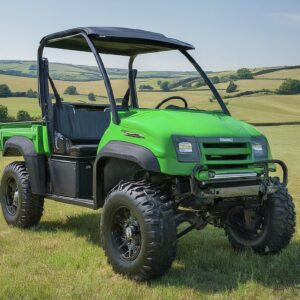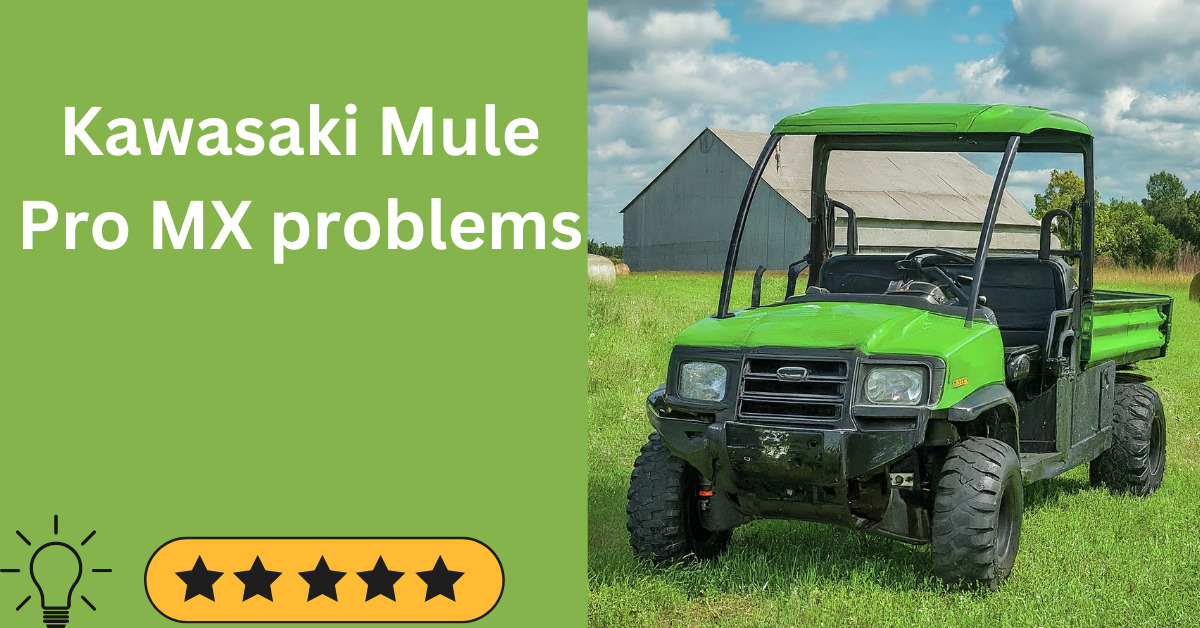The Kawasaki Mule Pro MX is a popular utility vehicle known for its durability and versatility. However, like any machine, it may encounter some problems over time. In this article, we will discuss 5 major Kawasaki Mule Pro MX problems and provide solutions to help you troubleshoot and resolve these issues.
Kawasaki Mule Pro MX problems
Here are the major problems of Kawasaki with their easy solutions.
1. Kawasaki Mule Pro MX starter problems

If you’re experiencing starter problems with your Kawasaki Mule Pro MX, it can be frustrating, but there are steps you can take to troubleshoot and possibly fix the issue.
Firstly, ensure that the battery is fully charged. A weak or dead battery can cause starter problems. You can use a multimeter to check the voltage of the battery. If it’s below the recommended level, try charging it fully and then attempt to start the Mule again.
Next, inspect the connections to the starter motor. Sometimes, loose or corroded connections can prevent the starter from getting enough power to turn over the engine. Clean any corrosion and tighten any loose connections you find.
If the battery and connections seem fine, the issue might lie with the starter motor itself. Over time, starter motors can wear out or become faulty. If you suspect this is the case, you may need to replace the starter motor.
It’s also a good idea to check the ignition switch and starter solenoid. Faults in these components can also prevent the starter from functioning properly. Ensure that the ignition switch is in the “on” position and that the starter solenoid is engaging when you try to start the Mule.
If you’re not comfortable diagnosing or fixing the issue yourself, it’s best to take your Kawasaki Mule Pro MX to a qualified mechanic or dealership. They’ll have the expertise and tools necessary to properly diagnose and repair the starter problem.
By following these steps, you can hopefully identify and resolve the starter problems with your Kawasaki Mule Pro MX, getting you back on the road or trail in no time.
2. Overheating Issues

If you own a Kawasaki Mule Pro MX and you’re facing overheating problems, it can be quite frustrating. But don’t worry, let’s break it down in simple terms to understand what might be causing this issue and how you can fix it.
- Check the Cooling System: The first thing to do is to inspect your Mule’s cooling system. Ensure that the radiator and coolant levels are adequate. Sometimes, a lack of coolant or a clogged radiator can lead to overheating.
- Inspect the Radiator: Take a look at the radiator for any visible signs of damage or blockage. Debris like mud, leaves, or insects might obstruct airflow, causing the engine to overheat. Clean the radiator thoroughly to ensure proper cooling.
- Coolant Leaks: Check for any leaks in the coolant system. Even a small leak can lead to a drop in coolant levels, resulting in overheating. Look for puddles beneath your vehicle or signs of coolant seepage around hoses and connections.
- Fan Operation: The cooling fan plays a crucial role in maintaining the engine temperature. Make sure the fan is functioning correctly. If it’s not turning on when the engine gets hot, there might be an issue with the fan motor or the temperature sensor.
- Thermostat: The thermostat controls how much cool liquid (coolant) goes through the engine. A faulty thermostat can cause irregular temperature control, leading to overheating. Consider replacing the thermostat if you suspect it’s malfunctioning.
- Airflow Restrictions: Inspect the area around the engine for anything that might be obstructing airflow. Ensure that vents and air passages are clear of any debris. Improving airflow can help in dissipating heat more effectively.
- Operating Conditions: Evaluate how you’re using your Mule. Are you pushing it too hard for an extended period? Overloading the vehicle or driving at high speeds for too long can strain the engine, leading to overheating. Try to moderate your speed and avoid overloading the vehicle beyond its capacity.
Also read Kawasaki KRX 1000 Problems
3. Rattling Noise

If you’re hearing a rattling noise coming from your Kawasaki Mule Pro MX, there could be a few potential causes. Let’s break down some common reasons and what you can do about them:
- Loose Components: One of the most common reasons for a rattling noise is loose components. This could include bolts, nuts, or other parts that have become loose over time due to vibration or wear and tear. Check all visible components, including the engine, exhaust system, and suspension parts, to ensure they are properly tightened.
- Worn-out Bushings or Bearings: Bushings and bearings are crucial for the smooth operation of various moving parts in your Mule Pro MX. If these components become worn out or damaged, they can produce a rattling noise as they move around excessively. Inspect the bushings and bearings in the suspension system, steering components, and drivetrain for any signs of wear or damage.
- Exhaust System Issues: A loose or damaged exhaust system can also cause a rattling noise. Check the exhaust system for any loose or broken hangers, brackets, or heat shields. Additionally, examine the exhaust pipes and muffler for any signs of damage or leaks that could be causing the rattling noise.
- Drive Belt Tension: If the drive belt is too loose or worn out, it can produce a rattling noise as it slips or moves around. Inspect the drive belt for any signs of wear, cracks, or damage, and adjust the tension if necessary according to the manufacturer’s recommendations.
- Suspension Components: Worn-out or damaged suspension components such as shock absorbers, springs, or sway bar links can also cause a rattling noise, especially when driving over bumps or rough terrain. Inspect these components for any signs of wear, damage, or looseness, and replace or repair them as needed.
- Drivetrain Issues: Problems with the drivetrain, such as worn-out CV joints or damaged universal joints (U-joints), can also result in a rattling noise, particularly during acceleration or deceleration. Inspect the drivetrain components for any signs of wear, damage, or excessive play, and replace them if necessary.
- Brake System: Loose brake calipers, pads, or rotors can also produce a rattling noise, especially when driving over uneven surfaces. Inspect the brake system components for any signs of looseness or damage, and tighten or replace them as needed.
If you’re unable to diagnose or fix the rattling noise on your own, it’s best to take your Kawasaki Mule Pro MX to a qualified mechanic or dealership for further inspection and repair. Ignoring a rattling noise could lead to further damage or safety hazards, so it’s important to address the issue promptly.
4. Idling problems

If you’re experiencing idling problems with your Kawasaki Mule Pro MX, there are a few common issues you can check and simple steps you can take to troubleshoot the problem.
- Check Fuel Level: Make sure that there’s enough fuel in the tank. Low fuel levels can cause irregular idling.
- Inspect Air Filter: A clogged or dirty air filter can disrupt the air-fuel mixture, leading to idling issues. Take out the air filter and clean it. If it’s really dirty, you might need to put in a new one.
- Examine Spark Plug: A worn-out or fouled spark plug can affect idling. Remove the spark plug, inspect it for signs of wear or fouling, and replace if needed.
- Inspect Carburetor: The carburetor may be dirty or clogged, affecting the engine’s idle. Clean the carburetor thoroughly or have it serviced by a professional if cleaning doesn’t resolve the issue.
- Check Throttle Cable: A loose or improperly adjusted throttle cable can cause idling problems. Ensure the throttle cable is properly adjusted and free from any obstructions.
- Examine Vacuum Hoses: Loose or damaged vacuum hoses can lead to air leaks, affecting engine performance. Inspect all vacuum hoses for cracks, leaks, or loose connections and replace them as necessary.
- Check for Fuel Contamination: Contaminated fuel can disrupt engine performance. Empty out the gas tank and fill it up with new, clean fuel.
- Inspect Idle Speed Setting: Incorrect idle speed settings can cause idling problems. Adjust the idle speed according to the manufacturer’s specifications.
- Check for Engine Issues: If none of the above steps resolve the problem, there may be underlying engine issues causing the idling problem. Consult a professional mechanic or Kawasaki service center for further diagnosis and repair.
5. Kawasaki Mule Pro MX Power Loss Issues

If you’re experiencing power loss issues with your Kawasaki Mule Pro MX, there are a few common reasons why this might be happening. Let’s break it down into simple terms:
- Fuel Issues: One of the main reasons for power loss in any vehicle, including the Kawasaki Mule Pro MX, could be related to fuel problems. This might include issues such as dirty fuel filters, clogged fuel lines, or bad fuel quality. If the engine isn’t getting clean fuel, it won’t run efficiently, leading to power loss.
- Air Filter: Another common culprit for power loss is a dirty or clogged air filter. The air filter is responsible for keeping dirt and debris out of the engine, but if it gets too dirty, it can restrict airflow and make it harder for the engine to breathe properly. This can result in reduced power output.
- Spark Plugs: Spark plugs are important because they create sparks that help start the engine by lighting the fuel and air mixture. If the spark plugs are worn out or fouled, they won’t be able to generate a strong spark, which can lead to misfires and decreased power.
- Engine Overheating: If the engine is running too hot, it can also cause power loss. This could be due to issues with the cooling system, such as a low coolant level, a malfunctioning radiator fan, or a clogged radiator. When the engine overheats, it can’t operate efficiently, resulting in decreased performance.
- Transmission Problems: Sometimes, power loss issues can stem from problems with the transmission. This could include issues such as low transmission fluid levels, worn-out clutch plates, or a malfunctioning transmission control unit. If the transmission isn’t working properly, it can’t transfer power from the engine to the wheels effectively, leading to power loss.
- Electrical Issues: Problems with the electrical system can also cause power loss. This might include issues such as a weak battery, faulty wiring, or a malfunctioning ignition system. If the electrical system isn’t providing enough power to the engine, it won’t be able to operate at its full potential.
Conclusion
While the Kawasaki Mule Pro MX is a reliable utility vehicle, it may encounter some problems over time. By being aware of these common issues and their solutions, you can troubleshoot and resolve problems effectively.
However, if you are unsure or unable to resolve the problem on your own, it is always best to consult a professional mechanic or Kawasaki dealer for assistance. Regular maintenance and proper care can go a long way in preventing and minimizing these issues, ensuring that your Kawasaki Mule Pro MX continues to serve you well for years to come.








